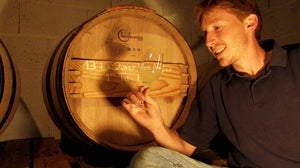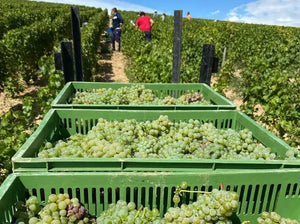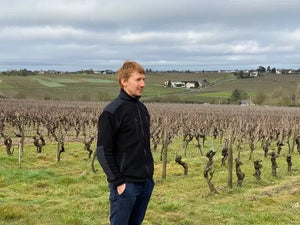Blog » Sauvignon Blanc
-
Bona Fide Naturalist: Werlitsch vom Opok
Wineries like Werlitsch in Austria's Styria region perpetuate those dreamy biodynamic farm vibes we've seen springing up in Eastern Europe. Sure, the scenes are breathtaking and make for a good selling point, but what winemaker Ewald Tscheppe produces from his opok-rich soils restores our faith in the far reaches of natural wine.
Our team once blind-tasted the Ex Vero I together. It had a matchstick quality on the nose, followed by white florals, fresh citrus, coconut milk-like texture, and electric acidity on the palate. Still, the wine's focal point was its lively energy and slightly waxy texture. I guessed it was from the Jura, thinking it had a Burgundy gone rogue feeling, but it turned out to be a blend of Sauvignon Blanc and Morillon (aka Chardonnay). Ex Vero is a three-part series showcasing the varied levels of altitude and soil composition on Werlitsch's steep hillside. These vines grow on limestone and clay soil rich in minerals and marine fossils, which locals refer to as opok. Frankly, the wines are unlike anything you'll taste from Austria or elsewhere.
Ewald and his friends discovered biodynamics while studying wine in the early 1980s. As a true devotee of the naturalist movement, he believes that nature always does it better—for him, that means gravity-flow winemaking, natural yeast, no temperature control, and no sulfur. In 2004, Ewald began to apply biodynamics to his family's estate, which also inhabits fruit trees, wild herbs, vegetables, and forests. -
Anjou Solar Eclipse: Pierre Menard LaïkaPierre Menard reaches cult status in Europe for his lieu-dit (single-vineyard) Chenin Blancs. Still, I'm beginning this producer introduction with a different wine, the Laïka Sauvignon Blanc. Simply put, Chenin gets the prime slopes in Anjou, where schist dominates, and the flatlands with boring soils may see some Sauvignon Blanc. However, Menard discovered one of the first Sauvignon Blanc parcels in this region, the tiny 1957-planted Clos de la Roche, located atop a slope in Faye d'Anjou.Before tasting Laïka, you'd be well served to expel any notion of what this variety's personality will deliver. "Typical" grapefruit and lime fade into the background, much like Earth did when the first living creature, the dog Laïka, was rocketed into space in 1957 (hence, the name). Those flavors are replaced by saffron butter, a kaleidoscope of yellow fruits, and a mineral underpinning that only the schist-laden slopes of Anjou convey. A Parisian bistro summer sipper, this is not.The fermentation and aging regimen is as progressive as Menard's desire to work with this Anjou outcast grape variety. Older barrels, sandstone amphora, and tanks are the vessels that combine to give us Laïka.
-
Sancerre Secret: Vincent Pinard FlorèsOne thrill of living in Beaune in 2012 was getting familiar with an enormous range of Burgundy producers. Beaune had its fair share of wine bars, and none devoted serious space to wines outside the region. That changed when the natural-focused Les Vins de Maurice opened in the spring, where wines from the Jura, Rhone, and Loire Valley covered the walls.
One day, I asked Maurice to introduce me to a new producer doing something unusual, and he quickly picked up a bottle of Vincent Pinard's Sancerre. I've been hunting for his wines ever since, brought to the U.S. by the same importer as Mugnier, Comte Liger-Belair, and Lafarge.
Pinard is in the village of Bué—some of the most prized vineyards in the region are here (alongside Chavignol). His wines are overtly stylish, each cuvée standing apart from one another. They have intense concentration and a gossamer texture that bears little resemblance to what we commonly expect from Sancerre.
Florès comes from a collection of vineyards in Bué. Aged in stainless steel tanks, the racy and crispy classic Sauvignon Blanc citrus notes mesh perfectly with Pinard's more layered and textural style. When fall hits, and I reach for Sancerre, this is the kind of secret overachiever that delivers! -
Anjou Outlier: Pierre Menard's Old-Vine Sauvignon Blanc
Pierre Menard reaches cult status in Europe for his lieu-dit (single-vineyard) Chenin Blancs. Simply put, Chenin gets the prime slopes in Anjou, where schist dominates, and the flatlands may see some Sauvignon Blanc. However, Menard discovered one of the first Sauvignon Blanc parcels in this region, the tiny 1957-planted Clos de la Roche atop a slope in Faye d'Anjou.
Before tasting Laïka, one should expel any notion of what this variety delivers. Typical grapefruit and lime fade into the background—much like earth did when the first living creature, a dog named Laïka, was rocketed into space in 1957—those flavors are replaced by saffron butter, a kaleidoscope of yellow fruits, and a mineral underpinning that only Anjou's schist-laden slopes convey.
Only a few cases of Laïka enter the U.S. each year. Also, do not miss Menard's stellar Chenin Blancs in equally small quantities. While we don't focus on many sweet/dessert wines, the "Cosmos" Coteaux du Layon (500 ml) blew us away. Perfect for pairing with cheese or dessert, but save the chocolate for Port!
.svg?v=162776257677185172071724397232)






